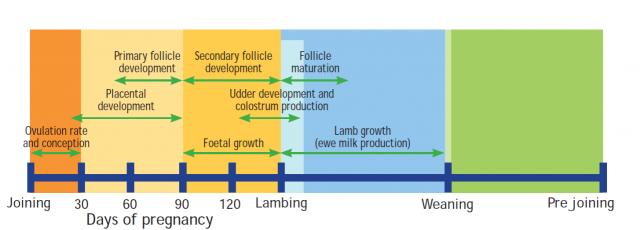The seven step reproductive cycle
There are seven important phases in the reproductive cycle of Merino ewes. The lifetimewool project has quantified the impact of nutrition on the production of the ewe and lamb in each of these phases. The cycle starts at joining (day 0), proceeds through lambing (day 150) and weaning (day 240), and finishes with the pre-joining management of ewes.
Management of ewe condition during each step of the cycle affects:
- conception success, reproductive rate, placental development, udder development and colostrum production of the ewe
- foetal growth of the lamb, including wool follicle development which influences wool production in the progeny
- ewe milk production, which influences lamb growth after birth.
The five key times to monitor ewe condition and health
These five key monitoring points cover the times when sheep are most likely to be in the yards, and also allow adequate time to address the flock’s nutrition before any impact is permanent.
| Phase | Time (in days) |
|---|---|
| Pre-joining | Day –60 from joining |
| Rams in (optional) | Day –60 from joining |
| Rams out | Day 0 |
| Pregnancy scanning | Day 90 from joining |
| Pre-lambing | Day 120 from joining |
| Weaning | 12 weeks from start of lambing |
Condition score and nutritional performance
Condition score is the most useful method of gauging the flock’s nutritional status and hence, performance. Assess between 25 and 50 sheep from the middle of the mob, or a random selection from each raceful.
Keep a written record of their condition or plot it on a chart like the one shown below to develop a condition score profile for that mob of ewes.
Ewe mortality rapidly increases when ewes are under condition score 2 and lamb mortality rapidly increases when their mothers are under score 2.5 during pregnancy.
Aim to have ewes around condition score 3 during joining and lambing, with twinning ewes increasing their condition score over late pregnancy to condition score 3.3.


